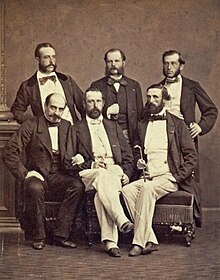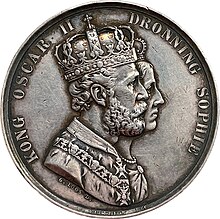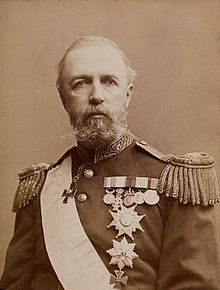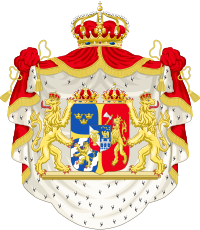Oscar II
| Oscar II | |||||
|---|---|---|---|---|---|
 Oscar II,c. 1900–07 | |||||
| King of Sweden | |||||
| Reign | 18 September 1872 –8 December 1907 | ||||
| Coronation | 12 May 1873 | ||||
| Predecessor | Charles XV | ||||
| Successor | Gustaf V | ||||
| King of Norway | |||||
| Reign | 18 September 1872 –7 June 1905 | ||||
| Coronation | 18 July 1873 | ||||
| Predecessor | Charles IV | ||||
| Successor | Haakon VII | ||||
| Born | 21 January 1829 Stockholm Palace,Stockholm,Sweden | ||||
| Died | 8 December 1907(aged 78) Stockholm Palace, Stockholm, Sweden | ||||
| Burial | 19 December 1907 | ||||
| Spouse | |||||
| Issue | |||||
| |||||
| House | Bernadotte | ||||
| Father | Oscar I of Sweden | ||||
| Mother | Josephine of Leuchtenberg | ||||
| Religion | Lutheran | ||||
| Signature | |||||
Oscar II(Oscar Fredrik;[1]21 January 1829 – 8 December 1907) wasKing of Swedenfrom 1872 until his death in 1907 andKing of Norwayfrom 1872 to 1905.
Oscar was the son ofKing Oscar IandQueen Josephine.He inherited the Swedish and Norwegian thrones when his brother died in 1872. Oscar II ruled during a time when both countries were undergoing a period of industrialization and rapid technological progress. His reign also saw the gradual decline of theUnion of Sweden and Norway,which culminated in itsdissolution in 1905.In 1905, the throne of Norway was transferred to his grandnephew PrinceCarl of Denmarkunder theregnal nameHaakon VII. When Oscar died in 1907, he was succeeded in Sweden by his eldest son,Gustaf V.
Oscar II is the paternal great-great-grandfather ofKing Carl XVI Gustaf of Sweden.King Frederik X of Denmarkis Oscar II's descendant through his son Gustaf V.King Harald V of Norway;King Philippe of the Belgians;andHenri, Grand Duke of Luxembourgare also descendants of Oscar II, all through his third sonPrince Carl, Duke of Västergötland.
Early life
[edit]
Oscar Fredrik was born at theRoyal PalaceinStockholmon 21 January 1829, the third of four sons ofCrown Prince OscarandJosephine of Leuchtenberg.[2]Upon his birth, he was createdDuke of Östergötland.At birth, he was fourth in thesuccession to the Swedish throneafter his father and older brothers, but as a younger son had no immediate prospect of inheriting the throne. During his childhood he was placed in the care of the royal governess, Countess Christina Ulrika Taube.[3]
Prince Oscar entered theRoyal Swedish Navyas a midshipman at the age of eleven, and was appointed junior lieutenant in July 1845. Later he studied atUppsala University,where he distinguished himself in mathematics.[4]On 13 December 1848, was made an honorary member of theRoyal Swedish Academy of Sciences.
On 6 June 1857, Prince Oscar marriedPrincess Sophia of Nassauat theBiebrich Palace,the ducal residence of theDuchy of Nassau.Princess Sophia was the youngest daughter of the deceasedWilhelm, Duke of Nassau,by his second wifePrincess Pauline Friederike Marie of Württemberg,and a half-sister ofAdolf,the then reigningDuke of Nassauand futureGrand Duke of Luxembourg.[2]

Upon the death of his father, King Oscar I, in 1859, Prince Oscar becameheir-presumptiveto the thrones of Sweden and Norway, as his eldest brother KingCharles XV of Sweden/Charles IV of Norwaywas without a legitimate heir, having lost his only son,Prince Carl Oscar, Duke of Södermanland,topneumoniain 1854. His second elder brother,Prince Gustaf, Duke of Uppland,had died oftyphoid feveralready in 1852.
King of Sweden and Norway
[edit]Accession
[edit]
Oscar II became King on 18 September 1872, upon the death of his brother,Charles XVwho died without an heir. At his accession, he adopted ashis mottoBrödrafolkens väl/Broderfolkenes Vel( "The Welfare of the Brother Peoples" ). Hiscoronation as Swedish monarchwas celebrated inStorkyrkanin Stockholm on 12 May 1873, and hiscoronation as Norwegian monarchtwo months later in theNidaros CathedralinTrondheimon 18 July 1873.[2]While the King, his family and theRoyal Courtresided mostly in Sweden, Oscar II made the effort of learning to be fluent inNorwegianand from the very beginning realized the essential difficulties in the maintenance of theunion between the two countries.[4]
Foreign and domestic statecraft
[edit]
His acute intelligence and his aloofness from the dynastic considerations affecting most European sovereigns (both his paternal and maternal grandfathers were French military commanders who served underNapoleon I) gave the king considerable weight as an arbitrator in international questions. At the request of the United Kingdom, Germany, and the United States in 1889 he appointed theChief Justice of Samoaunder theTreaty of Berlin,and he was again called on to arbitrate inSamoanaffairs in 1899.[4]

In 1897 he was empowered to appoint a fifth arbitrator if necessary in the Venezuelan dispute, and he was called on to act as umpire in the Anglo-American arbitration treaty that was quashed by theUnited States Senate.He won many friends in the United Kingdom by his outspoken and generous support of Britain at the time of theSecond Boer War(1899–1902), expressed in a declaration printed inThe Timesof 2 May 1900, when continental opinion was almost universally hostile.[4]
He remained a strong supporter of the Navy throughout his life, and frequently visited ships of the fleet. When thecoastal defence shipOscar IIwas launched, he even signed his name on the vessel's aft main gun tower.[5]
The office ofPrime Minister of Swedenwas instituted in 1876.Louis De Geerbecame the first head of government in Sweden to use this title. The most known and powerful first minister of the Crown during the reign of Oscar was the conservative estate ownerErik Gustaf Boström.Boström served as Prime Minister in 1891–1900 and 1902–1905. He was trusted and respected by Oscar II, who had much difficulty approving someone else as prime minister. Over a period of time, the King gave Boström a free hand to select his own ministers without much royal involvement. It was an arrangement (unintentional by both the King and Boström) that furthered the road to parliamentarism.
Science and the arts
[edit]
A distinguished writer and musical amateur himself, King Oscar did much to encourage the development of education throughout his dominions. In 1858 a collection of his lyrical and narrative poems,Memorials of the Swedish Fleet,published anonymously, obtained the second prize of theSwedish Academy.His "Contributions to the Military History of Sweden in the Years 1711, 1712, 1713", originally appeared in the Annals of the academy, and were printed separately in 1865. His works, which included his speeches, translations ofHerder'sCidandGoethe'sTorquato Tasso,and a play,Castle Cronberg,were collected in two volumes in 1875–76, and a larger edition, in three volumes, appeared in 1885–88.[4]
His Easter hymn and some other of his poems are familiar throughout the Scandinavian countries. His work onCharles XII of Swedenwere translated into English in 1879. In 1881 he founded the world's firstopen-air museum,atBygdøy,located next to hissummer residencenearOslo(back then known as Christiania). In 1885 he published hisAddress to the Academy of Music,and a translation of one of his essays on music appeared inLiteraturein May 1900. He had a valuable collection of printed and manuscript music, which was readily accessible to the historical student of music.[4]
Being a theater lover, he commissioned a new opera house to be built byAxel Anderbergfor theRoyal Swedish Operawhich was inaugurated on 19 September 1898. It remains as the home of that institution. Oscar II once told playwrightHenrik Ibsenthat hisGhostswas "not a good play". As he was dying, he requested that the theatres not be closed on account of his death. His wishes were respected.
Oscar was also particularly interested in mathematics. In 1889 he set up a contest, on the occasion of his 60th birthday, for "an important discovery in the realm of higher mathematical analysis".[6][7]The contest listed four potential areas of research, one of which was then-body problemincelestial mechanics,relevant to the stability ofthe solar system.Henri Poincare,a professor at theUniversity of Paris,won by submitting an entry showing that even the 3-body problem was unstable, the seminal result in what is now calledchaos theory.[8][9]
King Oscar II was an enthusiast of Arctic exploration. Along with Swedish millionaireOscar Dicksonand Russian magnateAleksandr Mikhaylovich Sibiryakov,he was the patron of a number of pioneering Arctic expeditions in the 1800s. Among the ventures the king sponsored, the most important areAdolf Erik Nordenskiöld's explorations to the Russian Arctic andGreenland,andFridtjof Nansen's Polar journey on theFram.[10]
Oscar was also a generous sponsor of the sciences and personally funded theVega Expedition,which was the first Arctic expedition to navigate through theNortheast Passage,the sea route between Europe and Asia through theArctic Ocean,and the first voyage to circumnavigate Eurasia.
Death
[edit]The political events which led up to the peacefuldissolution of the union between Norway and Swedenin 1905 could hardly have been attained but for the tact and patience of the king himself. He was dethroned on 7 June 1905 by theStortingand renounced theNorwegian throneon 26 October. He declined, indeed, to permit any prince of his house to become king of Norway, but better relations between the two countries were restored before his death.[4]Oscar II died inStockholmon 8 December 1907 at 9:10 am.[11]
Marriage and children
[edit]
Engraving byAnders Zorn.
On 6 June 1857 he married inWiesbaden-Biebrich,Duchy of Nassau(located in present-dayHessen,Germany)Princess Sophia Wilhelmina,the youngest daughter ofDuke William of NassauandPrincess Pauline of Württemberg.They had four sons:
- King Gustaf V(1858–1950)
- Prince Oscar, Duke of Gotland,later known as Prince Oscar Bernadotte,Count of Wisborg(1859–1953)
- Prince Carl, Duke of Västergötland(1861–1951)
- Prince Eugen, Duke of Närke(1865–1947)
His eldest son Gustaf was Duke ofVärmlandand succeeded him as King Gustaf V of Sweden from 1907 until 1950, marriedPrincess Victoria of Badenand they had three sons. His second son, Prince Oscar, lost his rights of succession to the throne upon his unequal marriage in 1888 to a formerlady-in-waiting,Ebba Munck af Fulkila,and was granted the title ofPrince Bernadottefirst in Sweden, and from 1892 inLuxembourg,where he also was createdCount of Wisborgas an hereditary title for his marital progeny (Adolphe, Grand Duke of Luxembourg,was the half-brother of his mother, Queen Sophia). The other sons of Oscar II were Prince Carl, Duke ofVästergötlandwho marriedPrincess Ingeborg of Denmark;and Prince Eugén, Duke ofNärke,who was well known as an artist and remained a bachelor all his life.
Alleged extramarital children
[edit]Oscar II is also suspected to have had several extramarital children,[12]of which at least five are named:
- Anna Hofman-Uddgren(1868–1947) by Emma Hammarström (1849–1910)[13]
- Elin Esping Smitz (1878–1960) by Paulina Mathilda Esping (1858–1878)[14][15]
- Knut August Ekstam (born 1878, in U.S.A. 1903, death unknown) byMarie Friberg(1852–1934)
- Florence Stephens(1881–1979) by Elisabeth Kreüger Stephens (1858–1911)[16]
- Nils Teodor Ekstam (1889–1954) also by Friberg above[17][18]
However, unlike his father, Oscar II never officially recognized any illegitimate children of his.
Honours
[edit]
- National[19]
- Knight and Commander of the Seraphim,21 January 1829
- Knight of theOrder of Charles XIII,21 January 1829
- Commander Grand Cross of the Sword,21 January 1829
- Commander Grand Cross of the Polar Star,21 January 1829
- Commander Grand Cross of theOrder of Vasa,15 June 1866[20]
- Grand Cross of St. Olav,with Collar,21 August 1847[21]
- Founder and Master of theOrder of the Norwegian Lion,21 January 1904 – 26 October 1905[22]
- Foreign[19]
 Anhalt:Grand Cross of theOrder of Albert the Bear
Anhalt:Grand Cross of theOrder of Albert the Bear Austria:Grand Cross of theRoyal Hungarian Order of St. Stephen,1866[23]
Austria:Grand Cross of theRoyal Hungarian Order of St. Stephen,1866[23] Baden:[24]
Baden:[24]
- Knight of theHouse Order of Fidelity,1877
- Knight of theOrder of Berthold the First,1877
 Bavaria:Knight of St. Hubert,1862[25]
Bavaria:Knight of St. Hubert,1862[25] Belgium:Grand Cordon of theOrder of Leopold,17 May 1856[26]
Belgium:Grand Cordon of theOrder of Leopold,17 May 1856[26] Brazil:Grand Cross of the Southern Cross
Brazil:Grand Cross of the Southern Cross Denmark:[27]
Denmark:[27]
- Knight of the Elephant,3 June 1848
- Cross of Honour of the Order of the Dannebrog,5 October 1863
 France:
France:
- Honour medal for Courage and Devotion,23 March 1862[28]
- Grand Cross of theLegion of Honour
- GoldMédaille militaire
 Greece:Grand Cross of the Redeemer
Greece:Grand Cross of the Redeemer Hanover:Grand Cross of theRoyal Guelphic Order,1852[29]
Hanover:Grand Cross of theRoyal Guelphic Order,1852[29] Hawaii:Grand Cross of theOrder of Kamehameha I
Hawaii:Grand Cross of theOrder of Kamehameha I Hesse-Darmstadt:Grand Cross of theLudwig Order,20 September 1881[30]
Hesse-Darmstadt:Grand Cross of theLudwig Order,20 September 1881[30] Italy:Knight of the Annunciation,10 January 1862[31]
Italy:Knight of the Annunciation,10 January 1862[31] Japan:Grand Cordon of theOrder of the Chrysanthemum,27 July 1881[32]
Japan:Grand Cordon of theOrder of the Chrysanthemum,27 July 1881[32] Mecklenburg:Grand Cross of the Wendish Crown,with Crown in Ore
Mecklenburg:Grand Cross of the Wendish Crown,with Crown in Ore Monaco:Grand Cross of St. Charles,16 January 1862[33]
Monaco:Grand Cross of St. Charles,16 January 1862[33] Nassau:Knight of the Gold Lion of Nassau,July 1858[34]
Nassau:Knight of the Gold Lion of Nassau,July 1858[34] Netherlands:Grand Cross of the Netherlands Lion
Netherlands:Grand Cross of the Netherlands Lion Luxembourg:Grand Cross of the Oak Crown
Luxembourg:Grand Cross of the Oak Crown Ottoman Empire:
Ottoman Empire:
- Order of Osmanieh,1st Class
- Order of Distinction
 Beylik of Tunis:Husainid Family Order
Beylik of Tunis:Husainid Family Order Portugal:
Portugal:
- Grand Cross of the Tower and Sword
- Grand Cross of theSash of the Three Orders
 Persia:House Order of the Imperial Effigy, 1st Class
Persia:House Order of the Imperial Effigy, 1st Class Prussia:
Prussia:
- Knight of the Black Eagle,28 September 1861;[35]with Collar
- Grand Cross of the Red Eagle
- Grand Commander's Cross of theRoyal House Order of Hohenzollern,12 June 1875[35]
 Romania:
Romania:
 Russia:
Russia:
- Knight of St. Andrew,9 July 1846
- Knight of St. Alexander Nevsky
- Knight of the White Eagle
- Knight of St. Anna,1st Class
- Knight of St. Stanislaus,1st Class
 Saxony:Knight of the Rue Crown,1875[36]
Saxony:Knight of the Rue Crown,1875[36] Saxe-Weimar-Eisenach:Grand Cross of the White Falcon,26 May 1862[37]
Saxe-Weimar-Eisenach:Grand Cross of the White Falcon,26 May 1862[37] Serbia:Grand Cross of the Cross of Takovo
Serbia:Grand Cross of the Cross of Takovo Siam:
Siam:
- Knight of theOrder of the Royal House of Chakri,29 October 1888
- Grand Cross of the White Elephant
 Spain:Knight of the Golden Fleece,14 July 1872[38]
Spain:Knight of the Golden Fleece,14 July 1872[38] United Kingdom:Stranger Knight Companion of the Garter,17 May 1881[39]
United Kingdom:Stranger Knight Companion of the Garter,17 May 1881[39] Venezuela:Collar of theOrder of the Liberator
Venezuela:Collar of theOrder of the Liberator Württemberg:Grand Cross of the Württemberg Crown,1879[40]
Württemberg:Grand Cross of the Württemberg Crown,1879[40]
Legacy
[edit]The name and portrait of Oscar II have been used as a trademark forKing Oscar sardinesin Norway since 1902[41](which remains the only brand to have once obtained his "royal permission" [42]) as well asgingerbreadcookies (pepparkakor) and other bakery products made byGöteborgs Kexin Sweden.[43]
Ancestry
[edit]| Ancestors of Oscar II | |||||||||||||||||||||||||||||||||||||||||||||||||||||||||||||||||||||||||||||||||||||||||||||||||||||||||||||||||||||||||||||||||||||||||||||||||||||||||||||||||||||||||||||||||||||||||||||||||||||||||||||||||||||||||||||||||||||||||||||||||||||||||||||||||||||||||||||||||||||||||
|---|---|---|---|---|---|---|---|---|---|---|---|---|---|---|---|---|---|---|---|---|---|---|---|---|---|---|---|---|---|---|---|---|---|---|---|---|---|---|---|---|---|---|---|---|---|---|---|---|---|---|---|---|---|---|---|---|---|---|---|---|---|---|---|---|---|---|---|---|---|---|---|---|---|---|---|---|---|---|---|---|---|---|---|---|---|---|---|---|---|---|---|---|---|---|---|---|---|---|---|---|---|---|---|---|---|---|---|---|---|---|---|---|---|---|---|---|---|---|---|---|---|---|---|---|---|---|---|---|---|---|---|---|---|---|---|---|---|---|---|---|---|---|---|---|---|---|---|---|---|---|---|---|---|---|---|---|---|---|---|---|---|---|---|---|---|---|---|---|---|---|---|---|---|---|---|---|---|---|---|---|---|---|---|---|---|---|---|---|---|---|---|---|---|---|---|---|---|---|---|---|---|---|---|---|---|---|---|---|---|---|---|---|---|---|---|---|---|---|---|---|---|---|---|---|---|---|---|---|---|---|---|---|---|---|---|---|---|---|---|---|---|---|---|---|---|---|---|---|---|---|---|---|---|---|---|---|---|---|---|---|---|---|---|---|---|---|---|---|---|---|---|---|---|---|---|---|---|---|---|---|---|
| |||||||||||||||||||||||||||||||||||||||||||||||||||||||||||||||||||||||||||||||||||||||||||||||||||||||||||||||||||||||||||||||||||||||||||||||||||||||||||||||||||||||||||||||||||||||||||||||||||||||||||||||||||||||||||||||||||||||||||||||||||||||||||||||||||||||||||||||||||||||||
Heraldry
[edit]| Heraldry of Oscar II of Sweden | ||||||
|---|---|---|---|---|---|---|
|
References
[edit]- ^Stockholm City Archives, archive of the Court parish, birth and baptism records, volume C I:5
- ^abcNevéus, Torgny (1992–1994)."Oscar II".Svenskt biografiskt lexikon(in Swedish). Vol. 28. p. 377.Retrieved5 May2024.
- ^Gustaf Elgenstierna, Den introducerade svenska adelns ättartavlor. 1925–36.
- ^abcdefgChisholm 1911.
- ^Borgenstam, Curt (2017)."Swedish Coastal Defence Ship Oscar II"(PDF).International Navy Journal.5(1): 65.ISSN2411-3204.Archived fromthe original(PDF)on 11 February 2020.Retrieved18 September2018.
- ^The scientific legacy of Poincaré.Charpentier, Éric., Ghys, E. (Etienne), Lesne, Annick. Providence, R.I.: American Mathematical Society. 2010. p. 165.ISBN9780821847183.OCLC426389803.
{{cite book}}:CS1 maint: others (link) - ^Stubhaug, Arild (2010)."King Oscar's Prize".Gösta Mittag-Leffler.pp. 377–380.doi:10.1007/978-3-642-11672-8_43.ISBN978-3-642-11671-1.
- ^"Chaos",Chaos: An Introduction to Dynamical Systems,Textbooks in Mathematical Sciences, New York, NY: Springer New York, 1996, pp. 105–147,doi:10.1007/0-387-22492-0_3,ISBN978-0-387-94677-1,archivedfrom the original on 9 July 2023,retrieved2 February2022
- ^The solution of the n-body problemArchived4 March 2016 at theWayback Machine,Florin Diacu. Mar 2016.
- ^Aho, Maire (January 1999), "AE Nordenskiöld Collection included in the Unesco Memory of the World Program",Tietolinja News,FI: Helsinki, archived fromthe originalon 7 July 2007.
- ^"Death Of Oscar King Of Sweden. His Son Ascends The Throne And Takes The Title Gustave The Fifth".The New York Times.9 December 1907.Archivedfrom the original on 20 December 2016.Retrieved11 February2017.
He Eulogizes His Father Tells Why The Country Should Cherish His Memory. In His Sentiments All Sweden Shares.
- ^Gustaf von PlateninBakom den gyllene fasadenBonniersISBN91-0-058048-1p 146
- ^Anna Hofmann – varietéstjärna och filmregissör,catalogue of exhibition by that name atStockholms Stadsmuséum1998 with essays by Åke Abrahamsson and Marika Lagercrantz/Lotte Wellton.
- ^Demitz, Jacob Truedson (1996).Throne of a Thousand Years.Ludvika, Sweden; Los Angeles: Ristesson Ent. p. 277.ISBN978-91-630-5030-5.
- ^"FamSAC of Stockholm & Blair – Family Tree".famsac.tribalpages.com.Archivedfrom the original on 26 March 2022.Retrieved8 July2022.
- ^Norlin, Arne (2015).Familjen Bernadotte: makten, myterna, människorna(in Swedish). Stockholm: Fischer & Co. pp. 218–220.ISBN9789186597962.SELIBR17803399.
- ^Sherlock Holmes and the King of ScandinaviaArchived16 March 2012 at theWayback MachineThe Swedish Pathological Society
- ^Sandberg, Mattias (24 May 2010)."Jakten på den försvunne sonen".Aftonbladet(in Swedish).Archivedfrom the original on 31 October 2013.Retrieved4 May2016.
- ^abSveriges statskalender(in Swedish), 1905, p. 438,archivedfrom the original on 21 August 2017,retrieved6 January2018– via runeberg.org
- ^Sveriges och Norges statskalender(in Swedish), 1870, p. 568,archivedfrom the original on 25 April 2018,retrieved6 January2018– via runeberg.org
- ^Sveriges och Norges statskalender(in Swedish), 1870, p. 690,archivedfrom the original on 19 July 2019,retrieved6 January2018– via runeberg.org
- ^"The Order of the Norwegian Lion"Archived10 August 2018 at theWayback Machine,The Royal House of Norway.Retrieved 10 August 2018.
- ^""A Szent István Rend tagjai"".Archived fromthe originalon 22 December 2010.
- ^Hof- und Staats-Handbuch des Großherzogtum Baden(1880), "Großherzogliche Orden"pp. 60Archived6 August 2020 at theWayback Machine,72Archived6 August 2020 at theWayback Machine
- ^Hof- und Staats-Handbuch des Königreichs Bayern(1906), "Königliche Orden"p. 7
- ^Ferdinand Veldekens (1858).Le livre d'or de l'ordre de Léopold et de la croix de fer.lelong. p.224.Archivedfrom the original on 9 July 2023.Retrieved17 December2020.
- ^Bille-Hansen, A. C.; Holck, Harald, eds. (1907) [1st pub.:1801].Statshaandbog for Kongeriget Danmark for Aaret 1907[State Manual of the Kingdom of Denmark for the Year 1907](PDF).Kongelig Dansk Hof- og Statskalender (in Danish). Copenhagen: J.H. Schultz A.-S. Universitetsbogtrykkeri. p. 3.Archived(PDF)from the original on 21 October 2020.Retrieved7 September2020– viada:DIS Danmark.
- ^"oscar-iis-franska-raddningsmedalj"[Oscar II's Rescue Medal] (in Swedish). 28 February 2018.Archivedfrom the original on 6 August 2020.Retrieved3 May2020.
- ^Staat Hannover (1865).Hof- und Staatshandbuch für das Königreich Hannover: 1865.Berenberg. p.81.
- ^Hof- und Staats-Handbuch des Großherzogtum Hessen(1883), "Großherzogliche Orden und Ehrenzeichen",p. 14Archived9 October 2021 at theWayback Machine
- ^Cibrario, Luigi (1869).Notizia storica del nobilissimo ordine supremo della santissima Annunziata. Sunto degli statuti, catalogo dei cavalieri(in Italian). Eredi Botta. p.118.Archivedfrom the original on 9 July 2023.Retrieved9 May2020.
- ^Hình bộ phương tắc (2017).Minh trị thời đại の huân chương ngoại giao nghi lễ(PDF)(in Japanese). Minh trị thánh đức ký niệm học hội kỷ yếu. p. 143.Archived(PDF)from the original on 28 March 2021.Retrieved17 August2020.
- ^Journal de MonacoArchived18 March 2022 at theWayback Machine
- ^Staats- und Adreß-Handbuch des Herzogthums Nassau(1866), "Herzogliche Orden"p. 8Archived7 April 2023 at theWayback Machine
- ^ab"Königlich Preussische Ordensliste",Preussische Ordens-Liste(in German),1,Berlin:6,935,1886,archivedfrom the original on 18 August 2021,retrieved22 August2021
- ^Sachsen (1876).Staatshandbuch für den Freistaat Sachsen: 1876.Heinrich. p.3.Archivedfrom the original on 9 July 2023.Retrieved24 June2020.
- ^Staatshandbuch für das Großherzogtum Sachsen / Sachsen-Weimar-Eisenach(1864), "Großherzogliche Hausorden"p. 13Archived30 August 2019 at theWayback Machine
- ^"Caballeros de la insigne orden del toisón de oro",Guía Oficial de España(in Spanish), 1887, p. 146,archivedfrom the original on 22 December 2019,retrieved21 March2019
- ^Shaw, Wm. A. (1906)The Knights of England,I,London,p. 66
- ^Hof- und Staats-Handbuch des Königreich Württemberg(1907), "Königliche Orden" p. 28
- ^"About King Oscar".kingoscar.com.Archivedfrom the original on 7 July 2019.Retrieved7 July2019.
- ^"King of the sea".The Norwegian American.7 September 2016.Archivedfrom the original on 7 July 2019.Retrieved6 July2019.
- ^"Kung Oscar"(in Swedish).Göteborgs Kex AB.Archivedfrom the original on 7 July 2019.Retrieved7 July2019.
- This article incorporates text from a publication now in thepublic domain:Chisholm, Hugh,ed. (1911). "Oscar II.".Encyclopædia Britannica.Vol. 20 (11th ed.). Cambridge University Press. p. 346.
Further reading
[edit]- Cronholm, Neander N. (1902).A History of Sweden from the Earliest Times to the Present Day.Chicago, New York [etc.] The author. pp.301–10.
- .The American Cyclopædia.1879.
- ..1914.
External links
[edit] Media related toOscar II of Swedenat Wikimedia Commons
Media related toOscar II of Swedenat Wikimedia Commons- The Royal Norwegian Order of St Olav – H.M. King Oscar II the former Grand Master of the Order
- 1829 births
- 1907 deaths
- 19th-century Swedish monarchs
- 20th-century Swedish monarchs
- 19th-century Norwegian monarchs
- 20th-century Norwegian monarchs
- People from Stockholm
- House of Bernadotte
- Swedish Lutherans
- Swedish people of French descent
- Uppsala University alumni
- Members of the Royal Swedish Academy of Sciences
- Swedish monarchs of German descent
- Burials at Riddarholmen Church
- Swedish Freemasons
- Dethroned monarchs
- Dukes of Östergötland
- Grand Masters of the Order of Charles XIII
- Knights of the Order of Charles XIII
- Commanders Grand Cross of the Order of the Sword
- Commanders Grand Cross of the Order of the Polar Star
- Commanders Grand Cross of the Order of Vasa
- Knights of the Order of the Norwegian Lion
- Grand Crosses of the Order of Saint Stephen of Hungary
- Recipients of the Cross of Honour of the Order of the Dannebrog
- Grand Cross of the Legion of Honour
- Recipients of the Order of the Netherlands Lion
- Grand Crosses of the Order of Christ (Portugal)
- Grand Crosses of the Order of Aviz
- Grand Crosses of the Order of Saint James of the Sword
- Recipients of the Order of the White Eagle (Russia)
- Recipients of the Order of St. Anna, 1st class
- Knights of the Golden Fleece of Spain
- Extra Knights Companion of the Garter
- Sons of kings
- Grand Crosses of the Order of Saint-Charles






